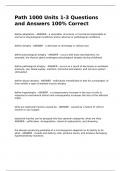Path 1000 Units 1-3 Questions
and Answers 100% Correct
define adaptation - ANSWER - a reversible, structural, or functional responsible to
normal or physiological conditions and to adverse or pathological conditions
define atrophy - ANSWER - a decrease or shrinkage in cellular size
define physiological atrophy - ANSWER - occurs with early development, for
example, the thymus gland undergoes physiological atrophy during childhood
define pathological atrophy - ANSWER - occurs as a result of decreases in workload,
pressure, use, blood supply, nutrition, hormonal stimulation, and nervous system
stimulation
define disuse atrophy - ANSWER - individuals immobilized in bed for a prolonged. of
time exhibit a type of skeletal muscle atrophy
define hypertrophy - ANSWER - a compensatory increase in the size of cells in
response to mechanical stimuli and consequently increases the size of the affected
organ
what are asphyxial injuries caused by - ANSWER - caused by a failure of cells to
receive or use oxygen
asphyxial injuries can be grouped into four general categories, what are they -
ANSWER - suffocation, strangulation, chemical asphyxiants, and drowning
the disease producing potential of a microorganism depends on its ability to do
what - ANSWER - invade and destroy cells, produce toxins, and produce damaging
hypersensitivity reactions
,define hyperplasia - ANSWER - an increase in the number of cells, resulting from an
increase rate of cellular division, hyperplasia, as a response to injury, occurs when
the injury has been severe and prolonged enough to have caused cellular death
define compensatory hyperplasia - ANSWER - an adaptive mechanism that enables
certain organs to regenerate, for example, removal of part of the liver leads to
hyperplasia of the remaining liver cells to compensate for the loss
define hormonal hyperplasia - ANSWER - occurs chiefly in estrogen-dependent
organs, such as the uterus and breast, after ovulation for example, estrogen
stimulates the endometrium to grow and stick in in preparation for receiving the
fertilized ovum
define pathological hyperplasia - ANSWER - the abnormal proliferation of normal
cells, usually in response to excessive hormonal stimulation or growth factors on
target cells, the most common example is pathological hyperplasia of the
endometrium
define dysplasia - ANSWER - refers to abnormal changes in the size, shape, and
organization of mature cells, dysplasia is not considered a true adaptive process but
is related to hyperplasia and is often called atypical hyperplasia
define metaplasia - ANSWER - the reversible replacement of one mature cell type by
another, sometimes less differentiated, cell type
define hypoxia - ANSWER - lack of oxygen within cells, is the single most common
cause of cellular injury
what is the most common cause of hypoxia - ANSWER - ischemia (reduced blood
supply)
what are the mechanisms of ischemia- reperfusion injury - ANSWER - oxidative
stress, increased intracellular calcium concentration, inflammation, complement
activation
why are free radicals dangerous - ANSWER - Highly reactive
,Can cause trouble depending on where it pulls electron
LDL --> Atherosclerosis
Proteins --> Cataracts
DNA --> Cancer
define necrosis - ANSWER - the sum of cellular changes after local cellular death and
the process of cellular self digestion, known as autodigestion or autolysis
what are the different types of necrosis - ANSWER - Coagulative
Liquefactive
Caseous
Fatty
gangrenous
gas gangrene
what is apoptosis - ANSWER - an important distinct type of cellular death that differs
from necrosis in several ways, it's an active process of cellular self-destruction
called programmed cellular death and is implicated in both normal and pathological
tissue changes
death by apoptosis causes loss of cells in many pathological States, including what -
ANSWER - severe cellular injury, accumulation of misfolded proteins, infections,
obstruction in tissue ducts
what is autophagy - ANSWER - a self destructive process and a survival mechanism,
it involves the delivery of cytoplasmic contents to the lysosome for degradation
define pathophysiology - ANSWER - Study of the underlying physiological process
associated with disease
what is pathogenesis - ANSWER - the manner in which a disease develops
, what is clinical manifestation - ANSWER - A term used when signs(objective) &
symptoms (subjective) are presented by a client
define etiology - ANSWER - cause of disease
define idiopathic - ANSWER - unknown cause
define iatrogenic - ANSWER - Disease and/or injury as a result of medical
intervention
define epidemiology - ANSWER - The study of the distribution and determinants of
health-related states or events in specified populations, and the application of this
study to the control of health problems.
define endemic - ANSWER - (of a disease or condition) regularly found among
particular people or in a certain area.
define epidemic - ANSWER - the occurrence of disease in excess of normal in a
specific community or region, usually occurring suddenly and spreading rapidly;
"outbreak"
define pandemic - ANSWER - (of a disease) prevalent over a whole country or the
world.
define morbidity - ANSWER - Refers to ill health in an individual and the levels of ill
health in a population or group.
define mortality - ANSWER - the incidence of death in a population
define prognosis - ANSWER - a forecast about the probable course of an illness
Define Sequelae - ANSWER - long-term or permanent damage to tissues or organs,
unwanted outcome




